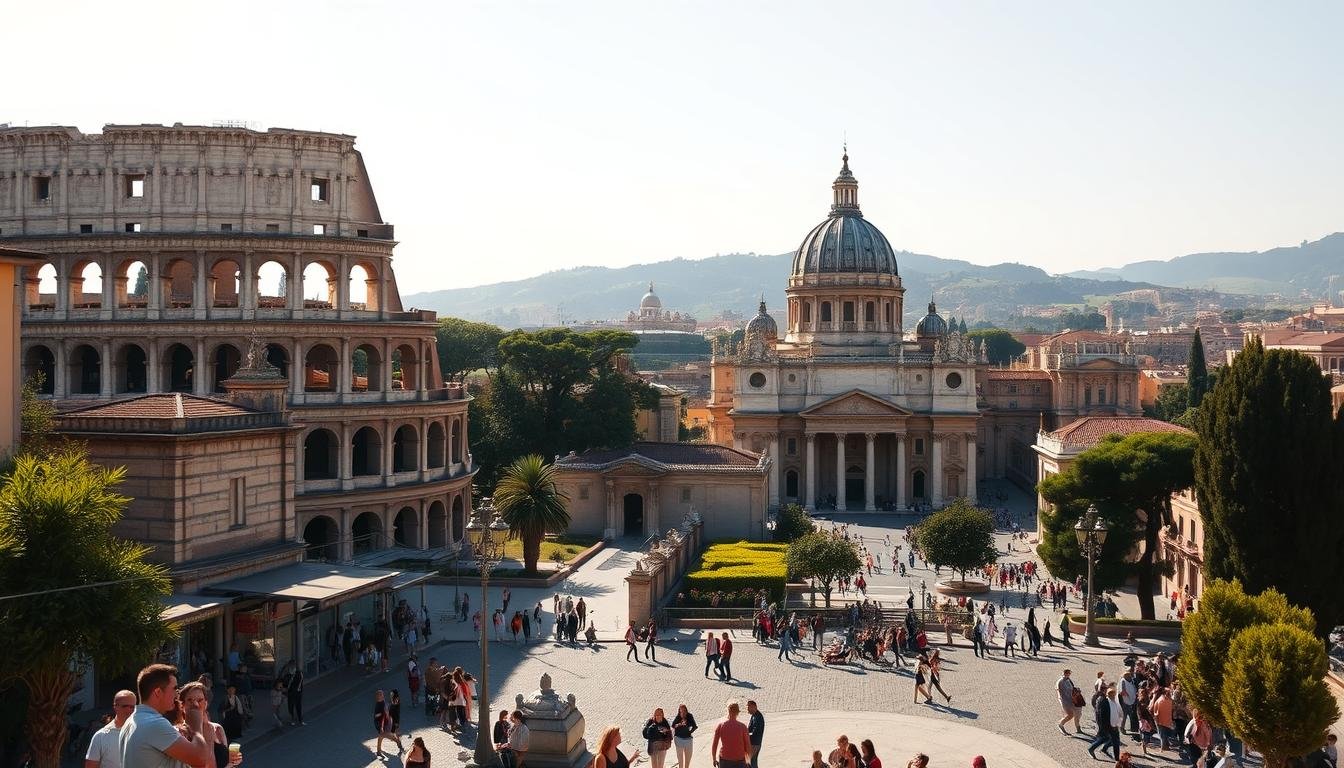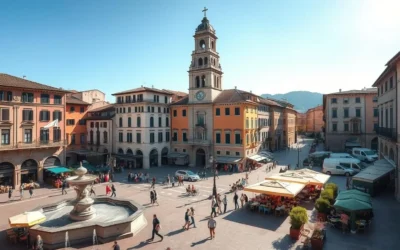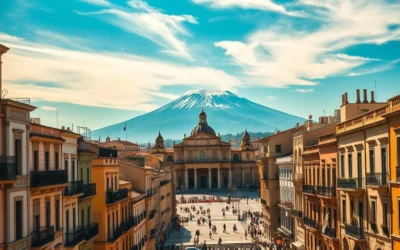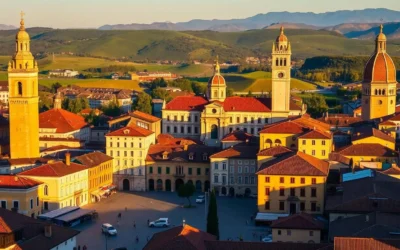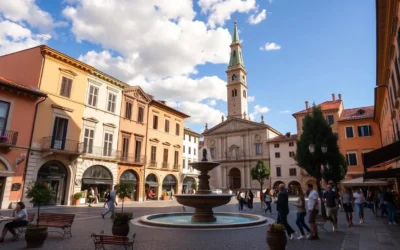✓ Accommodations✓ Flights✓ Rental Cars✓ Tours & Activities
Did you know that over 9 million visitors explore this timeless destination every year? With its Mediterranean climate, this city offers a unique blend of history, culture, and stunning weather. However, choosing the right time to visit can make or break your experience.
Understanding seasonal weather variations is key to planning your trip. Whether you’re strolling through ancient ruins or enjoying a leisurely evening, the right conditions can enhance your journey. This guide will help you pick the ideal time for your adventure, combining travel tips, local insights, and budget-friendly advice.
From scorching summers to mild winters, this destination offers diverse climates throughout the year. By aligning your visit with optimal weather, you’ll ensure a memorable and comfortable experience. Let’s dive into the details to help you plan your perfect getaway.
Introduction to Italy’s Seasonal Charms
Italy’s weather is as diverse as its landscapes, offering something for every traveler. From sunny coasts to cooler hills, each region has its own unique climate. Understanding these variations can help you plan the perfect trip.
Understanding the Mediterranean Climate
The Mediterranean climate brings hot summers and mild winters to much of the country. During the season, temperatures can soar, especially in coastal areas. However, spring and fall offer milder weather, making them ideal for exploring.
These transitional periods are perfect for outdoor activities. You’ll avoid the summer crowds while enjoying pleasant days. Whether you’re visiting a bustling city or a quiet village, timing your trip can make all the difference.
The Role of Italy’s Micro-Climates
Italy’s micro-climates add another layer of complexity. For example, the north experiences cooler temperatures, while the south stays warmer year-round. This diversity means you can enjoy different regions at the same time.
Understanding these nuances is crucial for planning. If you’re attending a local event, knowing the typical weather can help you pack wisely. Similarly, choosing the right part of the day for sightseeing can enhance your experience.
By aligning your travel plans with the season, you’ll make the most of your journey. Whether it’s a sunny afternoon in Tuscany or a crisp morning in the Alps, Italy’s climate offers endless possibilities.
Exploring Seasonal Weather Patterns in Italy
Italy’s weather patterns vary dramatically from north to south, offering unique experiences in every region. Whether you’re exploring bustling cities or serene countryside, understanding these differences can make your trip more enjoyable.
Regional Variations: North, Central, and South
In the north, cities like Milan often experience foggy mornings and cooler temperatures, especially in winter. Summers can be warm, but the heat is less intense compared to the south. Central regions, including Tuscany, enjoy mild springs and autumns, making these seasons ideal for travel.
Southern areas, such as Sicily, are known for their hot, dry summers. Winters here are milder but can be windy and rainy. These regional differences mean you can experience diverse climates in a single trip, depending on your itinerary.
Climate Change and Its Impact
Climate change is altering Italy’s weather patterns, bringing more extreme heatwaves and unpredictable rainfall. Summers in cities like Rome are becoming hotter, with temperatures often exceeding 40°C. This shift affects not only comfort but also the best time to visit.
Flexibility is key when planning your trip. Real-time weather alerts can help you adjust your schedule to avoid extreme conditions. Recognizing these changes ensures you make the most of your journey, no matter the season.
Selecting Your Perfect Month: Rome, Italy: Best Months for a Weather-Savvy Trip
Choosing the right month for your trip can make all the difference in your experience. Weather, crowd levels, and daylight hours all play a role in shaping your journey. By aligning your visit with the ideal time, you can enjoy a more comfortable and memorable adventure.
Spring, from March to May, offers mild temperatures and fewer crowds. This is the best time visit for outdoor activities and exploring without the summer heat. Days are longer, giving you more hours to explore.
Summer, from June to August, is peak tourist season. While the weather is hot, it’s perfect for early morning or late evening outings. Planning your day around the cooler parts of the hour can help you avoid the midday heat.
Fall, from September to November, brings cooler temperatures and vibrant autumn colors. It’s another great time to visit, with fewer tourists and pleasant weather. Winter, from December to February, is quieter and cooler, offering a unique charm with festive events.
Here’s a quick comparison of the seasons to help you decide:
| Season | Temperature | Crowd Level | Best For |
|---|---|---|---|
| Spring | Mild (13°C – 24°C) | Moderate | Outdoor activities, sightseeing |
| Summer | Hot (29°C – 32°C) | High | Early morning or evening outings |
| Fall | Cool (17°C – 27°C) | Low | Exploring with fewer crowds |
| Winter | Cool (3°C – 15°C) | Low | Festive events, quiet exploration |
By considering these factors, you can select the perfect month for your trip. Whether you prefer the bustling energy of summer or the tranquility of winter, timing your visit ensures a rewarding experience.
Planning Your Itinerary Around Peak and Shoulder Seasons
Traveling during off-peak periods can transform your journey into a stress-free adventure. With fewer crowds and lower prices, you’ll have more flexibility to explore at your own pace. This approach is ideal for creating a carefully planned itinerary that maximizes your experience.
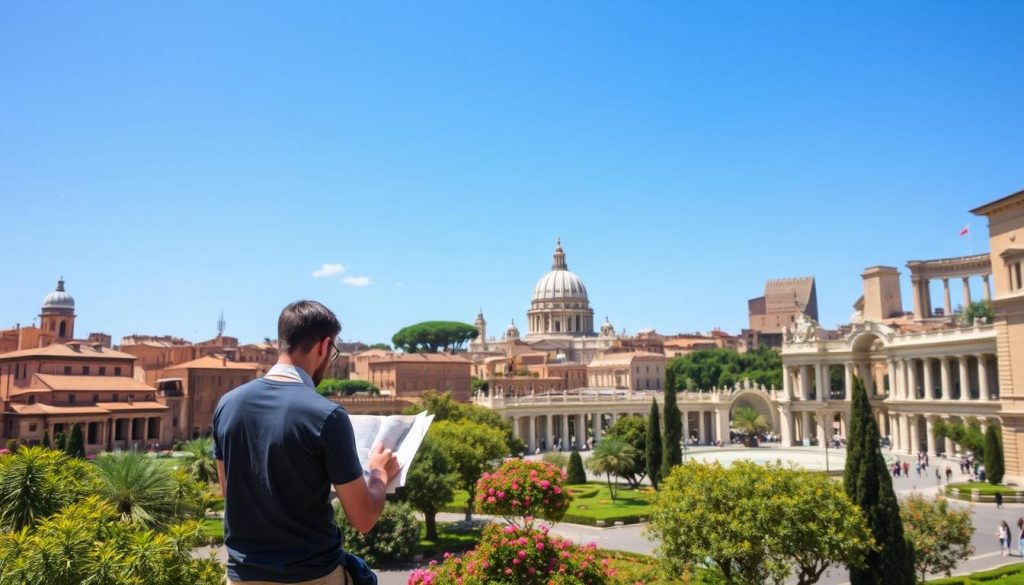
Advantages of Traveling Off-Peak
Off-peak travel offers numerous benefits. Lower tourist numbers mean you can enjoy popular attractions without long waits. This allows for a more relaxed and personalized itinerary, giving you time to immerse yourself in the local culture.
Additionally, prices for flights and accommodations are often significantly lower during these periods. This makes it easier to stick to your budget while still enjoying a memorable trip. Mild temperatures during shoulder seasons also make outdoor activities more enjoyable.
How to Strategize Your Daily Activities
Planning your day around peak hours can help you avoid crowds. Start early in the morning or explore in the late afternoon when most tourists are taking breaks. This strategy ensures you make the most of your time while staying comfortable.
Flexible scheduling is another key advantage. If unexpected weather occurs, you can easily adjust your plans without disrupting your entire itinerary. By understanding the best time to visit, you can streamline your activities and focus on what matters most.
| Season | Crowd Level | Price Range | Best For |
|---|---|---|---|
| Peak | High | Expensive | Festivals, events |
| Shoulder | Moderate | Affordable | Sightseeing, outdoor activities |
| Off-Peak | Low | Budget-friendly | Relaxed exploration |
By incorporating these tips into your travel plans, you can enjoy a seamless and rewarding experience. Whether you’re exploring bustling cities or serene countryside, timing your visit during off-peak periods ensures a stress-free adventure.
City-Specific Insights for Iconic Destinations
Exploring iconic destinations requires understanding their unique climates and how they shape your experience. Each city has its own weather patterns, affecting everything from outdoor attractions to museum visits. Timing your tour to align with favorable conditions can make your trip more enjoyable.
Rome’s Unique Urban Climate
Rome’s urban climate is known for its intense summer heat, with temperatures often exceeding 40°C (104°F). This can make midday sightseeing uncomfortable, especially in crowded areas. To avoid the heat, plan your activities for early mornings or late evenings.
In winter, the city experiences milder temperatures, averaging around 10°C (50°F). This is a great time to explore outdoor attractions like the Colosseum without the summer crowds. December also brings festive events, such as the Feast of the Immaculate Conception, adding a unique charm to your visit.
A Glimpse at Florence and Venice
Florence offers a more temperate climate compared to Rome. Spring and fall are ideal for visiting, with temperatures ranging from 15°C to 24°C (59°F to 75°F). Museums like the Uffizi are less crowded during these seasons, allowing for a more relaxed experience.
Venice, on the other hand, can be unpredictable in winter, with frequent rain and occasional flooding. However, late January offers cold but sunny weather, perfect for exploring the canals without the usual tourist numbers. Carnevale in February is a highlight, but be prepared for increased crowds.
| City | Best Time to Visit | Average Temperature | Key Considerations |
|---|---|---|---|
| Rome | Spring, Fall | 15°C – 24°C (59°F – 75°F) | Avoid midday heat in summer; enjoy festive events in winter. |
| Florence | Spring, Fall | 15°C – 24°C (59°F – 75°F) | Fewer crowds at museums; mild weather for outdoor activities. |
| Venice | Late January, Spring | 5°C – 15°C (41°F – 59°F) | Cold but sunny in late January; avoid rain and flooding in winter. |
By tailoring your itinerary to each city’s specific climate, you can make the most of your trip. Whether it’s avoiding the summer heat in Rome or enjoying the quiet canals of Venice, understanding these nuances ensures a memorable experience.
Enjoying Italy’s Countryside and Coastal Regions
The countryside and coastal regions offer a serene escape from bustling city life. Whether you’re exploring vineyards or relaxing on pristine beaches, these areas provide a refreshing change of pace. Timing your trip to align with the right season ensures a memorable experience.
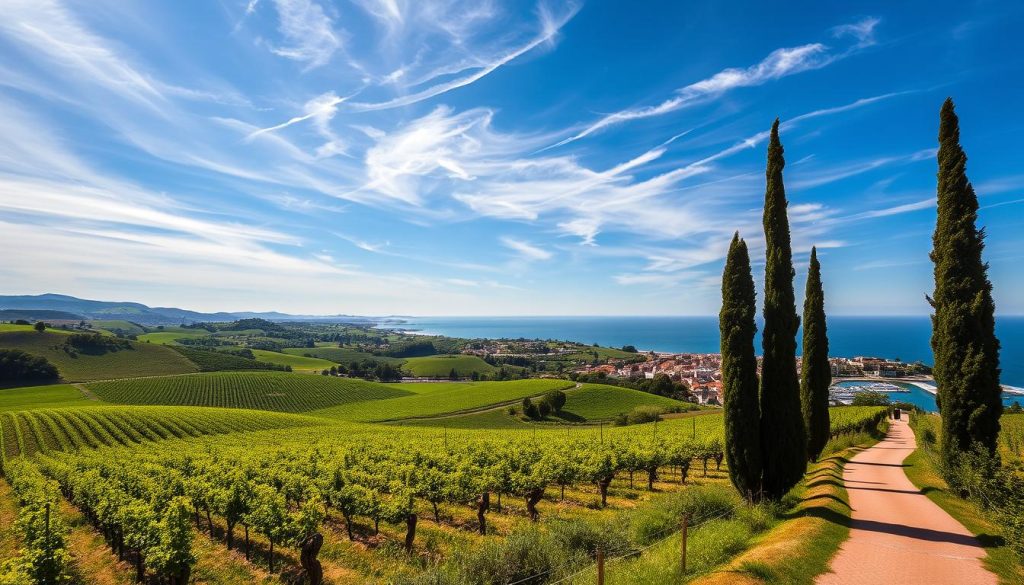
Vineyard Tours and Harvest Festivals
Fall is the perfect time visit for vineyard tours. During the harvest season, you can witness the grape-picking process and enjoy wine tastings. Many regions host festivals celebrating local food and wine, offering a unique cultural experience.
Plan your day around these events to make the most of your visit. Early mornings are ideal for vineyard tours, while afternoons can be spent savoring regional delicacies. These activities are less crowded in the shoulder months, making them even more enjoyable.
Relaxing Beach Days and Scenic Walks
Coastal regions are perfect for relaxed beach days and scenic walks. Summer is the peak season for sunbathing, but the shoulder months of spring and fall offer milder weather and fewer crowds. This makes it easier to find a quiet spot to unwind.
For a peaceful trip, consider visiting during winter. While the weather is cooler, the serene atmosphere and stunning views are worth it. Whether you’re strolling along the Amalfi Coast or exploring hidden coves, these coastal escapes are unforgettable.
By planning your activities by day, you can maximize natural light and scenic views. On rainy days, explore indoor cultural attractions like local museums or art galleries. This balance ensures a well-rounded experience, no matter the weather.
Embracing Local Festivals and Cultural Events
Immerse yourself in the vibrant culture of local festivals and events that bring communities to life. These celebrations offer a unique way to connect with the heart of a destination, showcasing its traditions, flavors, and artistic heritage. Whether you’re a foodie, history buff, or art enthusiast, there’s something for everyone to enjoy.
Food and Wine Celebrations
One of the highlights of any trip is indulging in local cuisine. Harvest festivals, often held in the fall, are a fantastic way to experience regional flavors. These events feature wine tastings, traditional dishes, and live music, creating a festive atmosphere. For example, the Umbria Jazz Festival combines world-class music with delicious food, making it a must-visit event.
To make the most of these celebrations, plan your day around the schedule. Arrive early to avoid crowds and enjoy the best attractions. Visiting during the shoulder season can also help you save on prices while still experiencing the excitement.
Historical Exhibits and Art Fairs
For history and art lovers, local exhibits and fairs provide a deep dive into the region’s cultural heritage. Events like the Venice Biennale showcase contemporary art from around the world, attracting both tourists and locals. These festivals often include workshops, guided tours, and interactive displays, offering a rich and immersive experience.
Timing your visit to coincide with these events can enhance your itinerary. For instance, the Palio di Siena, a historic horse race, is a thrilling spectacle that takes place in July. By planning ahead, you can secure tickets and avoid the peak crowds.
Here are some tips to make the most of local festivals:
- Check the monthly calendar for upcoming events.
- Visit during the shoulder season for fewer crowds and lower prices.
- Arrive early to enjoy the best attractions and activities.
- Engage with locals to discover hidden gems and lesser-known festivals.
By incorporating these tips into your travel plans, you’ll create a memorable and enriching experience. Local festivals and cultural events not only highlight the region’s heritage but also provide a deeper connection to its people and traditions.
Insider Tips for a Weather-Savvy Journey
Strategic planning can help you avoid crowds and enjoy more. By aligning your activities with the right time and season, you’ll make the most of your trip. Whether you’re exploring iconic landmarks or hidden gems, these tips will ensure a smooth and memorable experience.
Timing Your Sightseeing to Beat the Crowds
Popular attractions often have long lines, especially during peak hours. To minimize waiting times, visit early in the morning or late in the evening. For example, many museums open early, allowing you to explore before the crowds arrive.
Planning your tour around off-peak periods can also save you time. In winter, fewer tourists mean shorter lines and a more relaxed atmosphere. If you’re visiting during the summer, consider scheduling outdoor activities for cooler parts of the day.
Here are some strategies to beat the crowds:
- Start your day early to enjoy popular spots without the rush.
- Use skip-the-line tickets for major attractions.
- Plan evening outings when temperatures drop and crowds lessen.
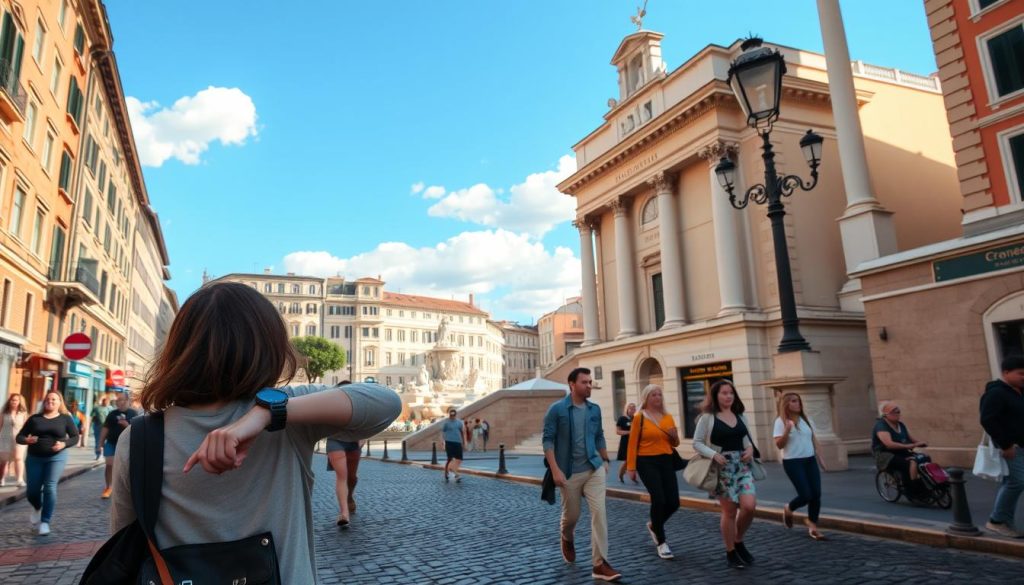
Advice on Hidden Gems and Local Spots
While iconic landmarks are a must-see, don’t overlook lesser-known local spots. These hidden gems often offer a more authentic experience and fewer crowds. For example, instead of visiting the most famous museum, explore smaller galleries or cultural centers.
Ask locals for recommendations on their favorite spots. They can point you to charming cafes, quiet parks, or unique tours that aren’t on the typical itinerary. This approach not only helps you avoid crowds but also deepens your connection to the destination.
Here’s how to discover hidden gems:
- Research local blogs or forums for insider tips.
- Visit neighborhoods off the beaten path.
- Attend local events or festivals for a unique experience.
By incorporating these tips into your travel plans, you’ll enjoy a smoother and more rewarding journey. Whether you’re exploring during the best time visit or discovering hidden treasures, smart planning ensures a stress-free adventure.
Budgeting Your Roman Getaway: Travel and Accommodation
Smart travelers know that timing is everything when it comes to saving money. By planning your trip during off-peak seasons, you can enjoy significant savings on flights, accommodations, and even tours. This approach not only helps you stick to your budget but also enhances your overall experience with fewer tourists and more personalized service.
Finding Deals During Off-Peak Seasons
Traveling during quieter periods, such as late fall or early spring, can unlock incredible price reductions. Flights and hotels often offer special promotions to attract visitors during these times. For example, accommodations in November through March are typically more affordable compared to peak holiday periods.
Using comparison sites can help you find the best prices for your travel needs. Booking in advance is another effective strategy, as it allows you to secure lower rates and avoid last-minute surges. Additionally, fewer crowds mean you can enjoy popular attractions like the Vatican museums without long waits.
Here are some practical tips for budgeting your trip:
- Plan your travel during shoulder seasons for lower costs and pleasant weather.
- Use flight alerts to track price drops and book at the right time.
- Consider staying in less central neighborhoods for more affordable accommodations.
By aligning your holiday with off-peak periods, you can enjoy a memorable and budget-friendly experience. With careful planning, your dream getaway is within reach.
Practical Travel Advice for Different Seasons
Packing smartly for your trip can make all the difference in your comfort and enjoyment. Each season brings unique weather challenges, so dressing appropriately is essential. Whether you’re exploring a bustling museum or strolling through scenic landscapes, the right wardrobe choices ensure a stress-free experience.

How to Dress and Pack Smartly
Layering is your best friend when traveling. In winter, pack warm base layers, a cozy sweater, and a waterproof jacket. For spring, opt for lightweight clothing that can be layered, as temperatures can fluctuate. During fall, bring a mix of long-sleeve shirts and a light jacket for cooler evenings.
Summer’s intense heat calls for breathable fabrics like cotton and linen. Don’t forget a wide-brimmed hat and sunglasses for sun protection. Comfortable walking shoes are a must, no matter the season, especially if your itinerary includes long days of sightseeing.
Here are some must-have accessories to consider:
- An umbrella or compact raincoat for unexpected showers.
- A versatile scarf that can double as a blanket or headcover.
- A reusable water bottle to stay hydrated throughout the day.
Practicality doesn’t mean sacrificing style. Choose neutral colors like black or brown for easy mixing and matching. This approach not only saves space but also ensures you’re prepared for any occasion, from a casual café visit to a formal museum tour.
By packing smartly, you’ll stay comfortable and stylish, no matter the temperature or time of year. A well-planned wardrobe is key to enjoying every moment of your journey.
Conclusion
Every season brings its own charm, making Rome a year-round destination. Whether you’re drawn to the vibrant energy of summer or the quiet beauty of winter, there’s always something to explore. Choosing the best time visit can profoundly shape your experience, from weather conditions to crowd levels.
Thoughtful planning is key to making the most of your trip. Consider how seasonal weather, local events, and tourist trends align with your preferences. For example, visiting during shoulder seasons like spring or fall offers milder temperatures and fewer crowds, while winter provides a unique charm with festive events.
Rome’s appeal lies in its ability to cater to every traveler, no matter the time of year. From savoring local food at harvest festivals to exploring historic sites without the summer rush, each season offers its own highlights. By tailoring your itinerary to the best time, you’ll enjoy a more personalized and memorable journey.
Reflect on the comparisons and insider tips shared throughout this guide. A balanced approach to timing and budgeting ensures a stress-free adventure. Whether you’re planning your first visit or returning to rediscover its magic, Rome promises an unforgettable experience.
Take the next step in planning your trip with confidence. Use the advice shared here to create an itinerary that suits your preferences and schedule. Rome’s timeless allure awaits, ready to welcome you at any part of the year.
Additional Insights and FAQs
Planning your trip with seasonal insights ensures a smoother and more enjoyable experience. One common question is how to handle the summer heat. The hottest days often occur in July and August, so plan outdoor activities for early mornings or late evenings to stay comfortable.
For museum visits, aim for weekdays and arrive early to avoid long lines. Many attractions are less crowded in the afternoon, making it an ideal time visit for a more relaxed experience. If you’re exploring during peak season, consider booking tickets online to save time.
Weather conditions can vary, so pack layers and check forecasts daily. This flexibility ensures you’re prepared for any changes during your travel. Additionally, holiday periods may bring larger crowds, so plan accordingly to enjoy a stress-free day.
For the savvy traveler, balancing budget and comfort is key. Traveling during shoulder seasons often means fewer crowds and lower costs. Whether you’re exploring historic sites or enjoying local cuisine, these tips help you make the most of your journey.
The above is subject to change.
Check back often to TRAVEL.COM for the latest travel tips and deals.
